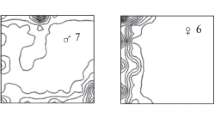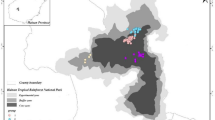Abstract
We report membership change in a group of wild agile gibbons, Hylobates agilis agilis, in West Sumatra, Indonesia. During 6-month observational periods, we focused on a particular unit of individuals known as the B group. We confirmed that the group consisted of five individuals: one adult female, one adult male, one subadult male, one subadult female, and one infant male. During our observations, the resident adult male and the two subadult individuals dispersed or disappeared, and a new adult male took over the group. We examined the effects of the male replacement on the territorial boundary, using the auditory census technique. The boundary was stable. We also documented the succession of the home range. Our results indicate a flexible social structure in this species and contribute some useful data to an ongoing debate on their social dynamics.


Similar content being viewed by others
References
Barelli C, Heistermann M, Boesch C, Reichard UH (2008) Mating patterns and sexual swellings in pair-living and multimale groups of wild white-handed gibbons, Hylobates lar. Anim Behav 75:991–1001
Bartlett TQ (2003) Intragroup and intergroup social interactions in white-handed gibbons. Int J Primatol 24:239–259
Brockelman WY (2009) Ecology and the social system of gibbons. In: Lappan S, Whittaker DJ (eds) The Gibbons. Springer, New York, pp 211–239
Brockelman WY, Reichard U, Treesucon U, Raemaekers JJ (1998) Dispersal, pair formation and social structure in gibbons (Hylobates lar). Behav Ecol Sociobiol 42:329–339
Farabaugh E (1982) The ecological and social significance of duetting. In: Kroodsma D, Miller E, Ouellet H (eds) Acoustic communication in birds. Academic Press, New York, pp 85–124
Fuentes A (2000) Hylobatid communities: changing views on pair bonding and social organization in hominoids. In: Yearbook of physical anthropology, vol 43. pp 33–60
Geissmann T (2002) Duet-splitting and the evolution of gibbon songs. Biol Rev 77:57–76
Groves C (2001) Primate taxonomy. Smithsonian Institution Press, Washington D.C.
Haimoff E (1984) Acoustic and organizational features of gibbon song. In: Preuschoft H, Chivers D, Brockelman W, Creel N (eds) The lesser apes: evolutionary and behavioural biology. Edinburgh University Press, Edinburgh, pp 333–353
Hooge P, Eichenlaub B (1997) Animal movement extension to arcview. ver. 1.1. In. Alaska Science Center—Biological Science Office, US Geological Survey, Anchorage
Lappan S (2007) Social relationships among males in multimale siamang groups. Int J Primatol 28:369–387
Leighton D (1987) Gibbons: territoriality and monogamy. In: Smuts B, Cheney D, Seyfarth R, Wrangham R, Struhsaker T (eds) Primate societies, vol 135–145. University of Chicago Press, Chicago
MacKinnon J, MacKinnon K (1977) The formation of a new gibbon group. Primates 18:701–708
Marshall J, Sugardjito J (1986) Gibbon systematics. In: Comparative primate biology, vol I. Alan R. Liss, Inc, New York, pp 137–185
Oyakawa C, Koda H, Sugiura H (2007) Acoustic features contributing to the individuality of wild agile gibbon (Hylobates agilis agilis) songs. Am J Primatol 69:777–790
Palombit R (1994a) Dynamic pair bonds in hylobatids: implications regarding monogamous social system. Behaviour 128:65–101
Palombit RA (1994b) Extra-pair copulations in a monogamous ape. Anim Behav 47:721–723
Palombit RA (1999) Infanticide and the evolution of pair bonds in nonhuman primates. Evol Anthropol Issues News Rev 7:117–129
Reichard U (1995) Extra-pair copulations in a monogamous gibbon (Hylobates lar). Ehology 100:99–112
Reichard UH, Barelli C (2008) Life history and reproductive strategies of Khao Yai Hylobates lar: implications for social evolution in apes. Int J Primatol 29:823–844
Sommer V, Reichard U (2000) Rethinking monogamy: the gibbon case. In: Kappeler P (ed) Primate males: causes and consequences of variation in group composition. Cambrige University Press, Cambridge
van Schaik CP, Dunbar RIM (1990) The evolution of monogamy in large primates: a new hypothesis and some crucial tests. Behaviour 115:30–62
White GC, Garrott RA (1990) Home range estimation. In: Analysis of wildlife radio-tracking data. Academic Press, San Diego
Whitten A (1982a) The ecology of singing in Kloss gibbons (Hylobates klossii) on Siberut Island, Indonesia. Int J Primatol 3:33–51
Whitten AJ (1982b) Home range use by Kloss gibbons (Hylobates klossii) on Siberut Island, Indonesia. Anim Behav 30:182–198
Acknowledgments
We thank Professor Hirohisa Hirai for his support. We especially thank Dr. Anas Salsabila, Dr. Mansyurdin, Dr. Syamsuardi, Dr. Tesri Maideliza, and the rest of the staff at Andalas University for their support at the field station in Sumatra, Indonesia; Dr. Dondin Sajuthi, Dr. Hery Wijayanto, and the other staff members at the IPB Primate Research Center for their support in Indonesia; Dr. Toshiaki Tanaka for valuable comments; Ms. Yoko Kaneko for helpful assistance in the data analysis; LIPI (Indonesian Institute of Science) for giving us permission to conduct the research; and an anonymous reviewer for improving our manuscript. This study was conducted under the Memorandum of Understanding between the Primate Research Institute, Kyoto University, and the Department of Biology, Andalas University. We adhered to the legal requirements of Indonesia. This study was supported by a Grant-in-Aid for overseas research (B) (20405016) to Hirohisa Hirai, and by the Global Centers of Excellence Program (A06) to Kyoto University, MEXT, Japan.
Author information
Authors and Affiliations
Corresponding author
About this article
Cite this article
Koda, H., Oyakawa, C., Nurulkamilah, S. et al. Male replacement and stability of territorial boundary in a group of agile gibbons (Hylobates agilis agilis) in West Sumatra, Indonesia. Primates 53, 327–332 (2012). https://doi.org/10.1007/s10329-012-0313-7
Received:
Accepted:
Published:
Issue Date:
DOI: https://doi.org/10.1007/s10329-012-0313-7




